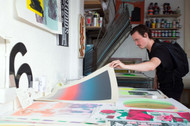Artist Interviews: Tom Hunter, Hannah Brown and Sam Winston for SPACE Open Studios 2018
Posted by Cass Art on 17th Jan 2018
SPACE is celebrating its 50th anniversary by hosting its biggest Artists’ Open Studios event ever! From 22-23 Sep, over 260+ artists across 12 of SPACE’s 19 buildings in London will be open to the public. In anticipation of SPACE open studios we spoke to three artists who will be throwing open their doors to the public next weekend. Learn more here about Hannah Brown’s luscious landscapes, Tom Hunters poignant photographs and Sam Winstons philosophical projects.

Hannah Brown 'The field next to Tesco that is soon to be built on, 4' Oil paint on marine plywood and oak 40cm x 47cm 2017
HANNAH BROWN
Hi Hannah, we can’t wait to find out more about your wonderfully painted landscapes!
Your paintings have a wonderful way of placing the viewer within an environment. Especially as you often paint the same scene from many different vantage points. For example in your series The field next to Tesco that is soon to be built on I feel as though I could be really standing where you were with the landscape around me.
Is this grounding of the audience import for you with your work?
Yes it’s extremely important and I’m really happy to hear you feel that way about the work. When I am in the landscape sketching I feel like I am collecting images. Most of these images will be single pieces (although in the series you mention, there was also a diptych) so obviously there is information beyond the edge of the picture plane that is omitted.
I enjoy this editing, as this is the translation from being in a physical landscape to making images from within that space. However I don’t want to lose the sense of having being in that particular environment completely so by showing vantage points that overlap or connect an essence of the landscape that the images came from can be brought into the gallery for the viewer to experience.
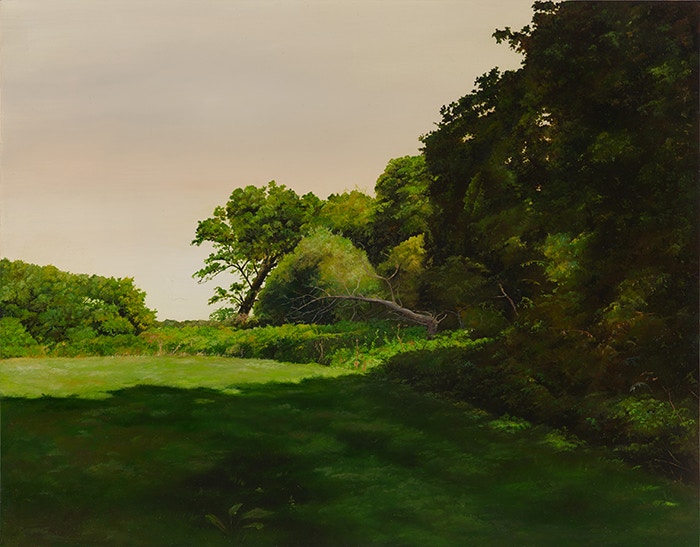
Hannah Brown, 'The field next to Tesco that is soon to be built on, 1' Oil paint on marine plywood and oak, 36cm x46cm 2016-17
The titles of your paintings are generally quite neutral; in that they literally name the place they represent, for example, Maryam Park and Victoria Park. However, there’s a difference with The field next to Tesco that is soon to be built on. It still performs the act of naming – as it literally is the field where Tesco will be, but it is also a time where we really hear your voice as the artist. You are asking us to become active in our viewing rather than remain a passive observer.
It calls the audience to question the future of the area, rather than just enjoy its beauty. Was this your intention? I for one can’t help but feel incredibly sad at the beautiful landscapes fate.
For a while I used more poetic titles such as ‘Waiting, still’ or ‘Time hangs heavy’ but I was concerned that I was leading the viewer too directly in how to respond to the work. I then started titling the work with the name of the place they come from and a number and allowed myself more lyrical titles for the exhibitions. At first the field next to Tesco that is soon to be built on series was called that because that was what I called the site for my own records. A very large Tesco was built on the edge of the town a few years ago and I found myself drawn to the land next to it. It was an unusual space as it wasn’t used for farming and had been partially altered to accommodate the planning requirements of the supermarket nearby. It was a conscious decision to keep the working title for the series as I hoped it would be a way to give the viewer a little more information about the space that was soon to be altered.
The site has now been built on and I am considering a further series of works that relate to the site’s change of use.
I am aware that I have romanticised the site by painting it and titling it in this way. I could find no objections to the site’s change of use. Out of context it appears like a beautiful landscape but in reality it is next to a main road, car park and chain pub and has been largely overlooked for many years.

Hannah Brown'The Field next to Tesco that is soon to be built on, 3', Oil paint on marine plywood and oak, each 23cm x 27cm, 2017
We’ve explored your relationship with your subject, now I’d love to delve into your relationship with materials! Working predominantly in oils could you briefly describe your working process with paint?
And do you find that you often return to specific materials again and again – such as a particular brush or paint brand, such as Winsor & Newton or Michael Harding?
I have slightly different processes for the large and small paintings. Both start off with site visits and sketches that are then brought into the studio. These are predominantly photographs but I do also sketch on paper. I take hundreds of photographs and spend quite a bit of time editing these into a selection that get printed. From the printed selection I then edit again into a small number that I make into charcoal or oil sketches on paper, sometimes both. For the large paintings these are then made into small oil on linen studies. All the while I am getting to know the image better and questioning whether I can work with it. As the paintings are quite labour intensive I try to make some decisions about colour and composition before embarking on the painting.
Many years ago a friend introduced me to Old Holland paints and I have mostly been using them ever since. There are some colours that I use Michael Harding or Winsor & Newton for such as, Indian yellow or Alizarin crimson. Brushes are more difficult to befriend, at the moment my preference is Shiro hog. I mostly use large Mottlers for the under-painting and filberts for the surface.
And finally! We’re very excited for the SPACE open studios here at Cass Art. What might visitors to your studio expect to see during their visit - any glimpses of an exciting new project?
Thank you! I am working towards a solo show that will be in London next year. I have one large painting completed and two in progress. Visitors will be able to see inside many working studios, my own included.
Visit Hannah on Sunday 23 September 2018 between 12-6pm at
Studio 12, Britannia Works, 56 Dace Road, E3 2NQ

TOM HUNTER
Hi Tom, we’re looking forward to learning more of the story behind the image!
I’ve just finished reading the introductory essay to your 2012 photography book “The Way Home” the streets must be, in part, unrecognisable from when you first moved to Hackney. I know the Fountain Pub is long gone and converted into flats!
Your work responds so directly and eloquently with your environment for example in your series “Life and Death in Hackney” prior to the Olympic Games in 2012. You live and work in the area - as the landscape around you evolves how is your relationship with Hackney changing? And do you think this change is coming through in your work?
Yes, parts of Hackney look very different today than it did say 30 years ago, especially around the east side of London Fields where I and a large community of people squatted in falling down terraced houses and a derelict warehouse. Now every time I walk down Mentmore Terrace there is another luxury apartment block magically risen from the rubble and another coffee shop grinding the bean. I now seem to be avoiding these new hot spots and am seeking out the quieter overlooked spaces around Hackney Marshes, the River Lea, the canals and reservoirs, maybe I’m trying to escape the relentless march of gentrification and all the beautiful people.
Your photographs act as a visual bridge between modern day life and that of the old masters. As they once painted and elevated the real people of the day you photograph and elevate the real people of our time. Indeed some of our readers may recognise the composition of your piece Anchor and Hope, which mirrors Christina’s World by Andrew Wyeth.
What continues to draw you to the works of artists such as Wyeth and Vermeer?
I always see the world through layers of history and in London the layers of history are so deep and so long, going back to the Celts and Romans and everything since then. Looking at other artists gives me insight into looking at the world through another lens, with all their unique visons, insights, histories and layers. At the moment I’m looking at the painting of Thomas Couture Romans during the Decadence, which weaves the lives of the gods with the lives of the mortals. I love to weave some of these myths into the everyday lives of Hackney today, which I’m trying to do.

Tom Hunter, Hackney Marshes from Figures in a Landscape series
Your recent exhibition Figures in a Landscape reflects your personal journey from a small Dorset village in the West Country to the Marshes of Hackney – with a mythical twist. How do you find intertwining your own personal experiences so closely with your work?
By looking into the histories and myths that surround us all, it’s easy to let my imagination run away and imagine myself in a Greek myth or a Roman tragedy. There are so many memories from living and hanging out in Hackney since 1979 that it feels very natural to draw on my own history and weave this into ancient worlds and tales. I have always loved reading or hearing stories, whether told in a local pub or read in an ancient book. Drawing these tales together is very exciting for me. In my Hackney Marshes image from Figures in a Landscape I have drawn on the ancient myth of a Celtic god Lugus, meaning 'bright river', which gives its name to the River Lea, where I made my photograph, with my memories of skinny dipping in the river on balmy summer nights from the past and present. So celebrating the present by evoking the past. I’m sure Lugus will be happy to come out of retirement.

Tom Hunter, Woodberry Down
Much of your practical making process takes part “in the field” as it were – could you talk us through a day in the studio of Tom Hunter? What might visitors to the SPACE open studios find when they come to your space at the Bridget Riley Studio?
My studio works in a number of different ways, I do use my studio to make photographic work. I have been photographing portraits and nudes there now for a number of years, so I have backdrops, lights and a chaise lounge for my sitters. I also use the studio for research so I have books and research material and as storage for my work, before it goes out to shows or comes back from shows, and lastly as an office so the boring stuff too. It’s very multi-purpose. Likewise my day in the studio is very diverse and varied, from all the boring stuff like writing emails and sorting out exhibitions, to the very exciting (for me) having someone new to photograph, with all its challenges and rewards. Having people in my studio is always the best part of any day, sharing a creative idea or vision, working with new partners and creating new work is the best feeling and makes everything worthwhile.
In my studio you will find a working photographic studio space, with a large 10x8 plate camera, so you are welcome to become a model in a shoot. Or just look at my prints, books and archive. Hope to see you there.
Visit Tom on Sunday 23 September 2018 between 12-6pm at
Studio 309, Bridget Riley Studios, 43 Dace Road, E3 2NG
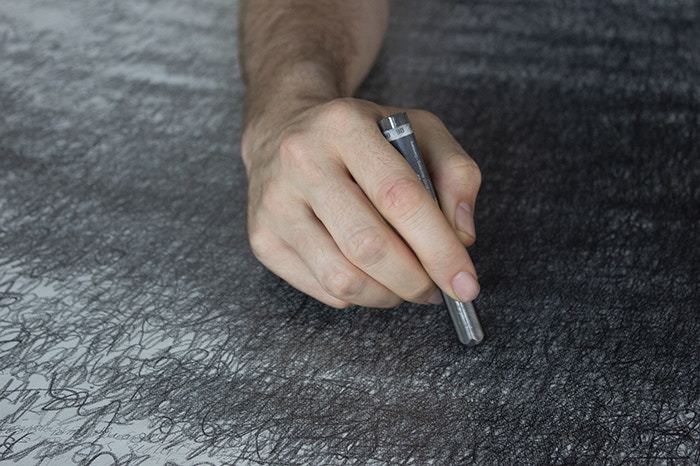
Sam Winston, Hand Dark
SAM WINSTON
Hi Sam, thanks for letting us delve in to your thought process!
Your work often acts as a measure to the passage of time. With either a repeated action over a number of hours, or restricting yourself to certain environments for a fixed period of time. How did you find that time behaved during your 7 days in complete darkness creating Darkness Visible?
Time disappears and re-appears all throughout the seven days. The moment you first wake up – all reference to time has gone [no watch to tell you how long you slept for] so you don’t know if it was a just five minute nap or a 24hr sleep. But then sometimes you will be given a time reference through sound - the most obvious ones being dawn chorus and / or rush-hour traffic – that lets you know roughly about evening / morning and therefore day / night..
In Drawing Breath you record the length of each exhalation you made during 15 hours through a mark on the page –the length of the mark equating to the length of the breath.
You describe the piece as “bridging the gap between our unconscious and conscious functioning” and indeed in looking at the work I became very aware of my own physicality. The longer I spent contemplating the marks my looking and breathing became more measured – more considered and in line with the marks.
Could you speak a bit about how you feel your relationships between your physical presence as an artist, the physical nature of the object relate to the physical experience of the viewer looking at a finished work?
One hopes that all pieces have some physiological effect on the viewer. I intentionally include a lot of ‘process’ in my final works – ie you can gauge how much labour or energy went into the final outcome through the marks left on the page. It’s a simple trick but because we seem to be incredibly empathic creatures – combined with the sheer amount of time it does take – that does seems bring the viewer somewhat into the process
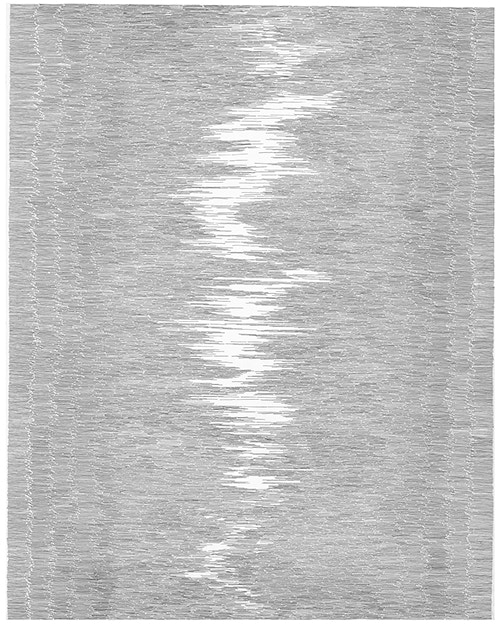
Sam Winson, Inhale
While your work is extremely contemporary the materials you use are exceptionally traditional – walking this line between tradition and contemporary must at times be quite challenging. Do you think that the historical position of your materials is vital in the internal conversations of the work? Would you achieve the same result using materials that are not positioned so strongly within art history?
The choice of materials came about from a few of factors. When I left college I realised how much of work culture was dependant on screen culture and my gut response was to move into the body and physical tools. Even though it seems to come and go out of fashion – craft to me simply means a certain type of embodied learning that bypasses my rational mind. I also wanted to begin to understand my tools in a different way - how they physically connected me with the world. The pencils cedar wood from California, its lead from graphite mines in China – that kind of knowledge. So that’s the line the work hopes to tread – this embodied process with contemporary thought.
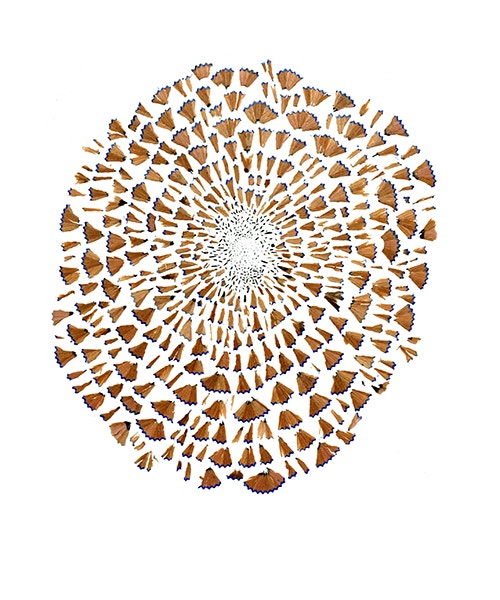
Sam Winson, Pencil Drawing
Why do you think that is?
I think you can use technology with that same principle. The added challenge with a lot of digital work is that the hardware is always enmeshed with software - personally I love taking anything apart – just with technology there’s a lot more to unravel.
Also I’ve just got to ask – which pencils are the best to deconstruct for your Pencil Drawing series?
To be honest when I first did it I think it was just old ones I had left over in the studio – so it’s hard to know what they were. But now – I would use any pencil that has a traceable supply chain [Blackwing for example]. Partly for environmental reasons but also because the work is so inherently about looking at the tool itself – the marks it makes to the world – before it makes its own marks.
And lastly! What might visitors to the SPACE open studios find when they come to see you in your studio – do you have anything exciting planned?
The studio is very much home to all my prints and drawings – so I will have a few of the large blind drawings on display, certainly the breath and pencil works and highly likely a fair few artist books. It’s a much loved space and it’s great to have the doors open to anyone and everyone.
Visit Sam on Saturday 22 September 2018 between 12-6pm at
Studio 311,The Triangle, Warburton Road, E8 3RT
SPACE OPEN STUDIOS
Discover work by some of the UK’s top artists – from internationally acclaimed names to new and emerging talent. This is an amazing opportunity to see behind the scenes of a working studio and meet the artists face to face. Private tours and guides will be on hand throughout the weekend to help you get the most from this spectacular Open Studios weekend.
Free & all welcome
Sat 22 Sep, 12 – 6pm: Studios in and around Hackney
Sun 23 Sep, 12 – 6pm: Studios in and around Tower Hamlets
For more information visit the SPACE website here.
Feeling Inspired?
Want to try your hand at your own landscape, or perhaps deconstruct a Derwent pencil or two of your own? Take a look online or pop in-store to talk to our staff artists who'd be happy to help with any questions you have about getting started. Don't forget to hashtag #cassart on social media to show us your creative endeavours!
lead image: The Triangle Open Studios at SPACE Summer Party 2016, Photo: Palida Boonyarungsrit

